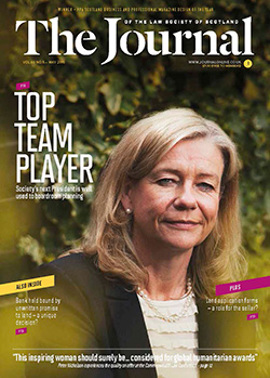Rearranging the family ties

Step-families are said to be the fastest growing type of family in the UK. So it is perhaps no surprise that step-parent adoptions are becoming increasingly common, with official figures showing 97 such adoptions out of a total of 489 adoptions in Scotland in 2013. In the recent decision of X v Y, 5 January 2015 (2015SCDUMF1), Sheriff Kelly considered an interesting case which is a helpful addition to the existing law.
This was an application for adoption by a stepmother in relation to her 14-year-old stepson, A. A’s mother had separated from his father around 2006 and later divorced. A residence order had been made in favour of A’s father. A resided with his father and the petitioner, who subsequently married. A’s mother had contact until around 2011, when A decided that he did not want any further contact. Following that, only one card had been sent by A’s mother by way of indirect contact. A continued to have contact with his adult siblings. A expressed a view that he wished to be adopted by his stepmother. A’s mother was not willing to consent and opposed the adoption. The social worker who compiled the report under s 19 of the Adoption (Scotland) Act 2007 recommended that the adoption be granted. The curator ad litem also supported the application. At first glance, the petitioner appeared to have a persuasive case.
Alternative outcomes?
The sheriff, however, refused the application, and instead made an order conferring parental rights and responsibilities on the petitioner and an order for residence in her favour under s 11(3)(b) of the Children (Scotland) Act 1995.
The sheriff was concerned that proper consideration had not been given to the alternatives to adoption by the curator and social worker. There was no account in either report of discussions with the parents and the child about alternatives to adoption. This significantly diminished the weight the sheriff felt he could give to their views.
A’s mother’s consent could only be dispensed with on the grounds set out in s 31(3) of the 2007 Act. The petitioner relied on two grounds: the mother’s inability to discharge parental rights and responsibilities satisfactorily, and/or the welfare of the child otherwise required her consent to be dispensed with. A’s mother argued that there was no inability on her part to discharge her parental rights and responsibilities: it was simply that she was not being allowed to do so. The sheriff agreed, and considered that on the evidence there was no inability on the mother’s part. Rather, she was well able to discharge her parental responsibilities and exercise her parental rights and was likely to continue to be able to do so. Therefore her consent could not be dispensed with on this ground.
Dispensing with consent
Thereafter the sheriff considered whether consent should be dispensed with on the welfare ground. Welfare was considered in the context of s 14 of the 2007 Act, which sets out the various considerations that a court must have regard to when considering whether to grant adoption. Regard had to be had to the need to safeguard and promote the child’s welfare throughout the child’s life as the paramount consideration. When assessing this, the sheriff had regard to A’s relationship with his older brother and sister and other extended members of his family. The sheriff considered the child’s views, observing that they carried considerable weight given the child’s age; however they remained one of a number of factors to be considered.
The sheriff followed the reasoning in S v L 2012 SLT 961, that dispensing with consent had to be necessary, rather than merely desirable or reasonable. The court had to be satisfied that nothing less than adoption would suffice. In the sheriff’s view there would have to be some “clear advantage in formalising the petitioner’s relationship with the child” for the adoption order to be granted. He therefore decided that a residence order and an order for parental rights and responsibilities would be sufficient to address concerns expressed by the petitioner and the child about the care of the child in the event of his father’s death. With these orders in place, the sheriff considered that there was no pressing need for an adoption order to be made.
These types of cases will turn on their own facts and circumstances. This case highlights the importance of considering adoption alongside the alternatives when advising clients, and ensuring that reports prepared in such cases cover all of the required issues.
In this issue
- Sham marriages v Sham interviews: which is the greater evil?
- A trusts law for the modern era?
- When cash just isn't good enough
- Un voyage en vaut la peine*: SYLA does France
- SYLA ends season on a high
- Appreciation: John Henderson
- Reading for pleasure
- Opinion: Mohammed Sabir
- Book reviews
- Profile
- President's column
- People on the move
- Application forms: should the seller adjust?
- When sharing matters
- After the launch
- Game of strategies
- Broken promises
- Charity legacies: the 10% conundrum
- Another "Whose money?" case
- Barrister barred
- Rearranging the family ties
- Belief in the system
- Living by the code
- The sky's the limit
- Unfinished business
- Law reform roundup
- Appreciation: Joseph Beltrami
- LBTT: what does it mean in practice?
- For those of a certain age
- Claims: trending?
- Ask Ash
- A man for all reasons
- The "TER approach"






